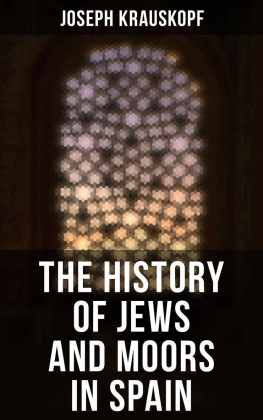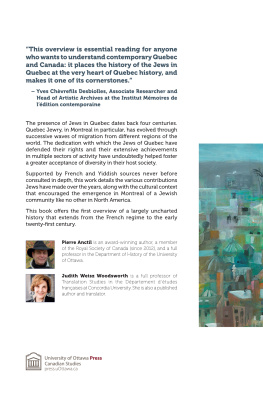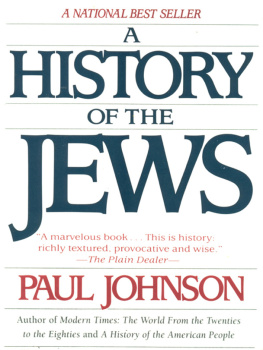CONTENTS
Introduction
Illusions of History: Man, God, and the Clash of Ideas
PRELUDE TO ACT I:
Prescription for Survival
Chronology For Act I
From Abraham To Jesus
ACT I
THE MANIFEST DESTINY
Prelude to Act II:
The Road to Mishna
ACT II
The Existentialist Dilemma
Chronology for Act II
From Jesus To Ben-Gurion
THE FIRST CHALLENGE
The Expanding Society of the Roman World
THE SECOND CHALLENGE
The Interim Society of the Parthian-Sassanid World
THE THIRD CHALLENGE
The Open Society of the Islamic World
PROGRAM NOTE
A Cross-Examination of the Crucifixion
THE FOURTH CHALLENGE
The Closed Society of the Feudal World
THE FIFTH CHALLENGE
The Regression of the Ghetto Age
THE SIXTH CHALLENGE
The Sick Society of the Scientific Age
ACT III
The Paradox Of the Diaspora
Chronology For Act III
From Ben-Gurion To The Messiah
Introduction
American Judaism: Wasteland or Renaissance?
A Note to the Reader
I. THE COLONIAL EXPERIENCE (16541776)
Grandees and Marranos
The Transformation of the British Anglicans into Hebraic Puritans
The Transformation of the Colonial Jews into Puritan Jews
The Collective Colonial Experience
II. THE ANTEBELLUM INTERLUDE (17761840)
From Moses Mendelssohn to Napoleon Bonaparte
The Transformation of the Ashkenazi Jews into Congregational Jews
III. THE MANIFEST DESTINY (18401890)
The Rise And Fall Of German Scientific Judaism
The Age of the American Reform Jews
IV. THE TIDAL WAVES OF IMMIGRATION (18801940)
Sad Sacks And Intellectuals
The Great Confrontation
V. ZIONISTS ON THE MARCH (18501950)
Revolt In the Shtetl
The Great Awakening
VI. The Unique and the Universal
The Great Fusion
Jews, God, and Destiny
Bibliography
General Jewish History
Religious and Philosophic Aspects of Jewish History
Aspects of American and European History

The Indestructible Jews
A FABLE OF OUR TIMES:
On the wall of a subway station in New York someone had scrawled:
God is dead.
Nietzsche
Someone else had crossed it out and scrawled underneath:
Nietzsche is dead.
God
Preface
For all too long, Jews and Christians have distorted Jewish history with so many pious frauds and smothered it with so much pious mythology that at times it has been difficult for scholar or layman to perceive its real grandeur.
It was not always thus. The Old Testament, most of it unequaled for sheer narrative skill, gives us an entirely different picture of Jewish historyproud, grand, and dynamic. It is also the first historical record, in the modern sense of the word, so accurate that an archaeologist can go to where the Bible said things happened and find the evidence.
The Greeks and Romans patterned their historical writings on the Jewish idea of history as a continuous biography of a people. But with the decline of Greece and the fall of Rome, the writing of objective history disappeared for close to a thousand years.
After the Renaissance it became the fashion in Church circles to denigrate Jewish history in order to ennoble the Christian view of things, thus reducing Jewish history to a meaningless, minor footnote. In ghetto circles, it became fashionable to count dead Jews in order to enhance Jewish suffering, thus reducing Jewish history to a meaningless, boring dirge.
In the nineteenth century, with the era of the German Enlightenment (Aufklrung), so-called scientific Judaism was born. A more apt phrase would be public-relations Judaism. In their eagerness to portray Jews to Christians as nice, tolerant, taxpaying citizens, German Reform Jewish scholars began to suppress anything they thought was unfavorable to the Jews. In their works, the Jew emerged as an innocent shnook, pushed by predatory Christians to the slaughter-bench of history. Retroactively, they conferred the crown of martyrdom on Jews all the way back to Abraham.
With the twentieth century, scholars at last began to discard the stereotypes of Church, ghetto, and apologetes. Modern scholarsboth Jewish and Christianbegan to reexamine Jewish history with new, objective, critical eyes. Jewish scholars especially began to arm themselves with general world history, religious and secular. They let the facts fall where they would, and as obscuring myths were discarded, Jewish history was revealed in a new light.
History can be compared to a vast smrgsbord, with the facts spread on a prepared table like exotic dishes, each vying for attention. There are two ways the historian can serve himself. He can close his eyes and help himself to a chance sampling of what the table has to offer, in which case he would have that highly praised mode of history known as objective. Or he can select those facts that suit his concept of history, in which case he would construct that highly criticized mode of history known as interpretive. We prefer the second school, becauseto paraphrase an epigram by Oscar Wildeobjective history gives us the dates of everything and the meaning of nothing. Facts in themselves have no intrinsic worth other than that they happened. Meaning can come only after facts have been sifted through the human mind and clothed with value.
The same holds true for every great work of art, which is not only an aesthetic presentation but a statement of value as well. For example, the Duke of Ferrara in Brownings My Last Duchess kills his wife because of her inability to make value judgments. In Brownings words, the Dukes complaint was:
Sir, twas all one! My favor at her breast,
The dropping of the daylight in the West,
The bough of cherries some officious fool
Broke in the orchard for her, the white mule
She rode with round the terraceall and each
Would draw from her alike the approving speech,
Or blush at least. She thanked men, good! but thanked
SomehowI know not howas if she ranked
My gift of a nine-hundred-years-old name
With anybodys gift.
Just as the Duke demanded from his Duchess a value differentiation between a bough of cherries and his nine-hundred-years-old name, so a reader can demand that a historian make a value differentiation between an earthquake killing a million people and a dictator ordering the murder of a like number of people. Not the quantity but the morality of the act is the meaningful factor.















